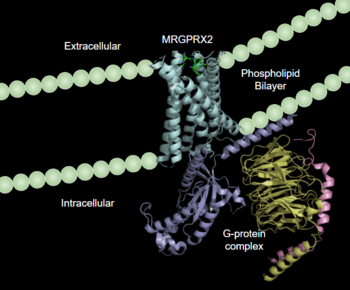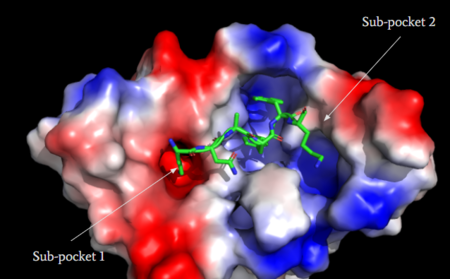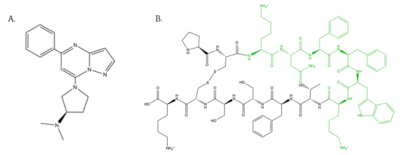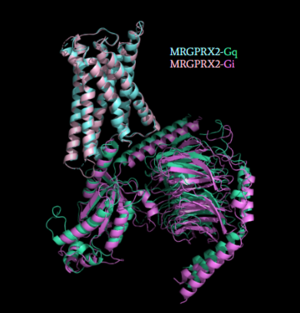Sandbox Reserved 1723
From Proteopedia
(Difference between revisions)
| Line 7: | Line 7: | ||
== G-Protein Coupled Receptors == | == G-Protein Coupled Receptors == | ||
| + | |||
[https://proteopedia.org/wiki/index.php/G_protein-coupled_receptors G-protein coupled receptors](GCPRs) are a large family of cell surface membrane receptors. Once bound to a wide variety of extracellular ligands, GCPRs undergo a conformational change and relay information to intracellular secondary messengers <ref name="Thal">Thal, David M., et al. "Structural insights into G-protein-coupled receptor allostery." Nature, Nature Publishing Group, 04 July 2018, https://www.nature.com/articles/s41586-018-0259-z</ref>. This G protein activation results in a cellular response dependent on the ligand bound and location of the GPCR in the body. GCPRs can be broken down into five families: the [https://en.wikipedia.org/wiki/Rhodopsin-like_receptors rhodopsin family (class A)], the [https://en.wikipedia.org/wiki/Secretin_receptor_family secretin family (class B)], the [https://en.wikipedia.org/wiki/Adhesion_G_protein-coupled_receptor adhesion family], the [https://en.wikipedia.org/wiki/Class_C_GPCR glutamate family (class C)], and the frizzled/taste family (class F) <ref name="Zhang">PMID: 26467290</ref>. All of the families have a similar transmembrane (TM) domain consisting of seven <scene name='90/904328/7tm_domain_pt_3/7'>α-helices</scene> complexed with intracellular G proteins. | [https://proteopedia.org/wiki/index.php/G_protein-coupled_receptors G-protein coupled receptors](GCPRs) are a large family of cell surface membrane receptors. Once bound to a wide variety of extracellular ligands, GCPRs undergo a conformational change and relay information to intracellular secondary messengers <ref name="Thal">Thal, David M., et al. "Structural insights into G-protein-coupled receptor allostery." Nature, Nature Publishing Group, 04 July 2018, https://www.nature.com/articles/s41586-018-0259-z</ref>. This G protein activation results in a cellular response dependent on the ligand bound and location of the GPCR in the body. GCPRs can be broken down into five families: the [https://en.wikipedia.org/wiki/Rhodopsin-like_receptors rhodopsin family (class A)], the [https://en.wikipedia.org/wiki/Secretin_receptor_family secretin family (class B)], the [https://en.wikipedia.org/wiki/Adhesion_G_protein-coupled_receptor adhesion family], the [https://en.wikipedia.org/wiki/Class_C_GPCR glutamate family (class C)], and the frizzled/taste family (class F) <ref name="Zhang">PMID: 26467290</ref>. All of the families have a similar transmembrane (TM) domain consisting of seven <scene name='90/904328/7tm_domain_pt_3/7'>α-helices</scene> complexed with intracellular G proteins. | ||
| Line 38: | Line 39: | ||
The sodium site motif facilitates the conformational change of GPCR upon activation.<ref name="Katritch">PMID: 24767681</ref> A sodium molecule sits in the middle of the TM7 helices where it is stabilized by conserved residues aspartate (TM2), serine (TM2), and three water molecules. The sodium is able to make a salt bridge with the aspartate at this position. The sodium acts similar to a ball joint in which it allows for the TM helices be spread apart and induce larger conformational change upon binding. In MRGPRX2 this motif is only partially conserved. The aspartate (TM2) is conserved while the serine is replaced by a glycine.<ref name="Yang"/> This creates a less favorable environment for the stabilization of sodium. Currently, in crystallization structures no sodium has been seen at this site. Thus making it inconclusive on whether it plays a role in the conformational change to activate G-proteins upon binding to the receptor.<ref name="Yang"/> | The sodium site motif facilitates the conformational change of GPCR upon activation.<ref name="Katritch">PMID: 24767681</ref> A sodium molecule sits in the middle of the TM7 helices where it is stabilized by conserved residues aspartate (TM2), serine (TM2), and three water molecules. The sodium is able to make a salt bridge with the aspartate at this position. The sodium acts similar to a ball joint in which it allows for the TM helices be spread apart and induce larger conformational change upon binding. In MRGPRX2 this motif is only partially conserved. The aspartate (TM2) is conserved while the serine is replaced by a glycine.<ref name="Yang"/> This creates a less favorable environment for the stabilization of sodium. Currently, in crystallization structures no sodium has been seen at this site. Thus making it inconclusive on whether it plays a role in the conformational change to activate G-proteins upon binding to the receptor.<ref name="Yang"/> | ||
| - | |||
== MRGPRX2 Signaling Pathway == | == MRGPRX2 Signaling Pathway == | ||
== 1. Binding Pocket == | == 1. Binding Pocket == | ||
| + | |||
MRGPRX2 consists of two binding pockets (seen in Figure 2). Sub-pocket 1 consists of primarily hydrophobic aromatic residues; Phe-170, Trp-243, and Phe-244.<ref name="Yang">Yang, Fan, et al. "Structure, function and pharmacology of human itch receptor complexes." Nature, Nature Publishing Group, 17 November 2021, https://www.nature.com/articles/s41586-021-04077-y</ref> These residues provide stabilization with ligands through stacking. This pocket also contains acidic catalytic residues Asp-184 and Glu-164 that interact with substrates by making ion pairs. Lastly, this pocket is in close proximity with the commonly conserved disulfide bond (formed by Cys-168 and Cys-180) seen in most Class A GPCRs. The second binding pocket forms electrostatic interactions with larger substrates (seen in Figure 2), but is generally less studied.<ref name="Cao"/> | MRGPRX2 consists of two binding pockets (seen in Figure 2). Sub-pocket 1 consists of primarily hydrophobic aromatic residues; Phe-170, Trp-243, and Phe-244.<ref name="Yang">Yang, Fan, et al. "Structure, function and pharmacology of human itch receptor complexes." Nature, Nature Publishing Group, 17 November 2021, https://www.nature.com/articles/s41586-021-04077-y</ref> These residues provide stabilization with ligands through stacking. This pocket also contains acidic catalytic residues Asp-184 and Glu-164 that interact with substrates by making ion pairs. Lastly, this pocket is in close proximity with the commonly conserved disulfide bond (formed by Cys-168 and Cys-180) seen in most Class A GPCRs. The second binding pocket forms electrostatic interactions with larger substrates (seen in Figure 2), but is generally less studied.<ref name="Cao"/> | ||
| Line 59: | Line 60: | ||
| - | + | == 2. MRGPRX2 interaction with G-Protein == | |
| + | |||
MRGPRX2 interacts with two different types of [https://en.wikipedia.org/wiki/G_protein#:~:text=G%20proteins%2C%20also%20known%20as,a%20cell%20to%20its%20interior. G-proteins], Gi and Gq. When activated these G-proteins will initiate the signal transduction pathway. These G-proteins are composed of 3 subunits; α, β, and γ. | MRGPRX2 interacts with two different types of [https://en.wikipedia.org/wiki/G_protein#:~:text=G%20proteins%2C%20also%20known%20as,a%20cell%20to%20its%20interior. G-proteins], Gi and Gq. When activated these G-proteins will initiate the signal transduction pathway. These G-proteins are composed of 3 subunits; α, β, and γ. | ||
| - | [[Image:Gq_and_Gi_snip.PNG| | + | [[Image:Gq_and_Gi_snip.PNG|300px|left|thumb|'''Figure 4''': Caption.<ref name="Cao"/>]] |
| + | |||
| + | == 3.After G-Protein Activation == | ||
| - | === 3.After G-Protein Activation=== | ||
MRGPRX2 mediates degranulation of mast cells through interaction with Gq and Gi subunits. Gq activation signals through [https://en.wikipedia.org/wiki/Phospholipase_C Phospholipase C], which catalyzes the cleavage of Phosphatidylinositol bisphosphate into [https://en.wikipedia.org/wiki/Diglyceride diacylglycerol (DAG)] and [https://en.wikipedia.org/wiki/Inositol_trisphosphate inositol trisphosphate (IP3)]. DAG is then able to increase the activity of [https://en.wikipedia.org/wiki/Protein_kinase_C protein kinase C]. IP3 receptor is ligand gated calcium channel on the endoplasmic reticulum (ER), that causes the release of calcium in cytoplasm. Subsequently, this results in muscle contraction and enzyme activation. | MRGPRX2 mediates degranulation of mast cells through interaction with Gq and Gi subunits. Gq activation signals through [https://en.wikipedia.org/wiki/Phospholipase_C Phospholipase C], which catalyzes the cleavage of Phosphatidylinositol bisphosphate into [https://en.wikipedia.org/wiki/Diglyceride diacylglycerol (DAG)] and [https://en.wikipedia.org/wiki/Inositol_trisphosphate inositol trisphosphate (IP3)]. DAG is then able to increase the activity of [https://en.wikipedia.org/wiki/Protein_kinase_C protein kinase C]. IP3 receptor is ligand gated calcium channel on the endoplasmic reticulum (ER), that causes the release of calcium in cytoplasm. Subsequently, this results in muscle contraction and enzyme activation. | ||
Revision as of 19:35, 20 April 2022
| This Sandbox is Reserved from February 28 through September 1, 2022 for use in the course CH462 Biochemistry II taught by R. Jeremy Johnson at the Butler University, Indianapolis, USA. This reservation includes Sandbox Reserved 1700 through Sandbox Reserved 1729. |
To get started:
More help: Help:Editing |
Human Itch GPCR
| |||||||||||
References
- ↑ 1.0 1.1 1.2 1.3 1.4 1.5 1.6 1.7 1.8 Cao, Can, et al. "Structure, function and pharmacology of human itch GPCRs." Nature, Nature Publishing Group, 17 November 2021, https://www.nature.com/articles/s41586-021-04126-6
- ↑ Thal, David M., et al. "Structural insights into G-protein-coupled receptor allostery." Nature, Nature Publishing Group, 04 July 2018, https://www.nature.com/articles/s41586-018-0259-z
- ↑ 3.0 3.1 Zhang D, Zhao Q, Wu B. Structural Studies of G Protein-Coupled Receptors. Mol Cells. 2015 Oct;38(10):836-42. doi: 10.14348/molcells.2015.0263. Epub 2015, Oct 15. PMID:26467290 doi:http://dx.doi.org/10.14348/molcells.2015.0263
- ↑ 4.0 4.1 4.2 Zhou Q, Yang D, Wu M, Guo Y, Guo W, Zhong L, Cai X, Dai A, Jang W, Shakhnovich EI, Liu ZJ, Stevens RC, Lambert NA, Babu MM, Wang MW, Zhao S. Common activation mechanism of class A GPCRs. Elife. 2019 Dec 19;8. pii: 50279. doi: 10.7554/eLife.50279. PMID:31855179 doi:http://dx.doi.org/10.7554/eLife.50279
- ↑ 5.0 5.1 5.2 5.3 5.4 5.5 5.6 5.7 Yang, Fan, et al. "Structure, function and pharmacology of human itch receptor complexes." Nature, Nature Publishing Group, 17 November 2021, https://www.nature.com/articles/s41586-021-04077-y
- ↑ 6.0 6.1 Schonegge, Anne-Marie, et al. "Evolutionary action and structural basis of the allosteric switch controlling β2AR functional selectivity." Nature, Nature Publishing Group, 18 December 2017, https://www.nature.com/articles/s41467-017-02257-x
- ↑ Sandoval, A., et al. "The Molecular Switching Mechanism at the Conserved D(E)RY Motif in Class-A GPCRs." Biophysical journal, 111(1), 79-89. https://doi.org/10.1016/j.bpj.2016.06.004
- ↑ Katritch V, Fenalti G, Abola EE, Roth BL, Cherezov V, Stevens RC. Allosteric sodium in class A GPCR signaling. Trends Biochem Sci. 2014 May;39(5):233-44. doi: 10.1016/j.tibs.2014.03.002. Epub , 2014 Apr 21. PMID:24767681 doi:http://dx.doi.org/10.1016/j.tibs.2014.03.002
- ↑ Babina, M., et al. "MRGPRX2 Is the Codeine Receptor of Human Skin Mast Cells: Desensitization through β-Arrestin and Lack of Correlation with the FcεRI Pathway." Journal of Investigative Dermatology, 141(6), 1286-1296. https://doi.org/10.1016/j.jid.2020.09.017
- ↑ McNeil, B. D., et al. "MRGPRX2 and Adverse Drug Reactions." Frontier Immunology, 06 August 2021, https://www.frontiersin.org/articles/10.3389/fimmu.2021.676354/full
- ↑ Ogasawara, H., et al. "Novel MRGPRX2 antagonists inhibit IgE-independent activation of human umbilical cord blood-derived mast cells." Journal of Leukocyte Biology, 12 July 2019, https://jlb.onlinelibrary.wiley.com/doi/10.1002/JLB.2AB1018-405R





